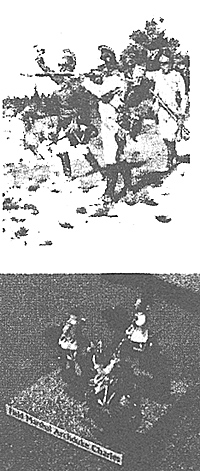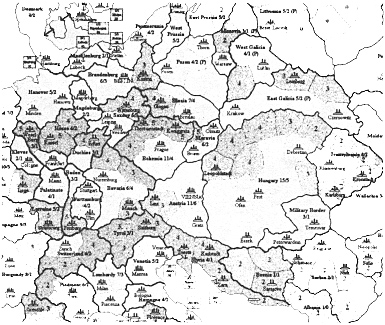 I have been assigned to the US Embassy in the beautiful city of Ottawa Canada for over a year and a half. I did not expect to find the great wargaming club that I happened across when I got here, just so happens I saw it through the pages of MWAN club listings. The group is a well-organized club named OMG (Ottawa Miniatures Gamers) that meets at none other than the Canadian War Museum [what a wonderful venue for a wargaming club]. The club and the museum is a great outlet for the public to see historical miniature wargaming and it is also a way for the club to attract new members and show the public what it does. Along with a monthly meeting the club sponsors two "I day gaming events": Spring Offensive and Autumn Assault, and a larger weekend convention called CANGAMES (usually in the spring).
I have been assigned to the US Embassy in the beautiful city of Ottawa Canada for over a year and a half. I did not expect to find the great wargaming club that I happened across when I got here, just so happens I saw it through the pages of MWAN club listings. The group is a well-organized club named OMG (Ottawa Miniatures Gamers) that meets at none other than the Canadian War Museum [what a wonderful venue for a wargaming club]. The club and the museum is a great outlet for the public to see historical miniature wargaming and it is also a way for the club to attract new members and show the public what it does. Along with a monthly meeting the club sponsors two "I day gaming events": Spring Offensive and Autumn Assault, and a larger weekend convention called CANGAMES (usually in the spring).
The group, approximately 50 strong, plays just about everything from ancients to WWII. I personally prefer 15mm Napoleonics, and was happy to see that the group played quite a bit of that era. They had just finished up an 1814 campaign and were not real happy with the mechanics of the game. Tod Creasy, who had GM'd the campaign, wanted to streamline the process. His goal was to involve less note taking and keep all the players actively interested in the events. His solution was to try a "Narrative Campaign". I had read a little about this system in MWAN and was interested. Along with the 1814 campaign the club was in the middle of an "Iron Marshal" campaign. The Iron Marshall campaign was a series of battles [1804-1815], pitting the French against the prominent allied enemy (one rattle per year). This is a subject for a future article, but the short version is that each player bids points and when all the battles are finished the one with the most points is awarded the Iron Marshal title! A great way to involve many club members and produce a wide variety of battles.
Once these two campaigns were finished we went to work developing the Narrative campaign. Being of Hungarian decent I quickly pushed for a campaign involving Austria. My miniature collection contains over 3,000 Austrian figures so that helped in my quest. The next step was to decide the timeframe to campaign. 1809 was a logical choice since it presented a pretty even match up and was short in duration (6 months historically). Next we opened up the commands (corps level) and club members signed up. Below is a list of the commands, starting provinces and players:
Imperial
Bavaria
Napoleon (Jean Vachon)
II Corps (Oudinot)
IV Corps (Massena) (Olivier Thomann)
Wuurtemburg Corps (Vandamme)
III (Davout) Corps (Duncan Allen)
I Cav Corps (Nansouty)
Bavarian Corps (Wrede) (Neal Howes)
Guard Corps (W alther)
IX (Saxon )Caps (Bernadotte) (Bob Spencer)
Italy
V Corps (Eugene) (Jean-Frangain Lazier)
VI Lombardy Corps (Grenier)
XI Corps (Marmont)
Poland
Polish Corps (Poniatowki) (Wind Kinastowski)
Austria
Bavaria
Archduke Charles (Charlie Torok)
Rosenburg (Will Cornish)
Hohenzollern (Vincent Clancy)
Hiller
Bohemia
Bellegarde (Corey Coleman)
Kollowrat
Western Austria
Archduke Louis
Leichtenstein (Marc Rivet)
Northern Austria
Kienmayer (George Wellington the Younger)
Italy/Illyria
Archduke John (Chris Evans)
Chasteler
A. Guilay
I. Guilay
Stoichewich
 Tod used the map from Empire in Arms to provide the backdrop for the strategic movement.
Tod used the map from Empire in Arms to provide the backdrop for the strategic movement.
Some notes
One area takes infantry 10 days or cavalry 6 days to cross (doubled for mountains).
One factor is a small brigade (2-3 regiments).
Capacity of a city is determined by fleches. One flech holds 5 factors (around 10 regiments). Defense value is determined by black triangles. The more there is the higher the defensive value.
All movement was accomplished by the players sending Tod a written (narrative) of what they wanted to do and how. Discussions between players were restricted to dispatches (controlled by Tod). This required some honesty and good sportsmanship, plenty of which resides here in the club. The GM then interprets the notes and dispatches and moves the forces. You have to be very clear on what you want to do or the GM may just move your forces differently than you expected, the old "don't assume" law works well in this system. Other than maintaining a general knowledge of what your command is doing on the map, there is very little game mechanics for the players to worry about (a big bonus for us players). I highly recommend clubs try this system out. It makes for a hassle free campaign and your campaigns tend not to die on the vine due to book keeping and a lack of interest.
Now on to the campaign:
Each national leader (myself as Archduke Charles and Jean Vachon as Napoleon) provided a written a-mail with our overall campaign plan and sent dispatches to our subordinate commanders. *[On a side note - Napoleonics work well here in Canada, we put all the French speakers on the French side to add to the overall flavor!].
The Austrian plan was designed to be very different from the actual 1809 campaign. Whereas the major effort in 1809 was the central Bavarian theater I chose to refuse the center and concentrate on the flanks (Northern Italy and Poland). I stripped the main army under Charles' command and sent 3 Corps to re-enforce the Italian army under Archduke John (Chris Evans) and I Corps to Poland to re-enforce General Kienmayer (George Wellington "the Younger"). This left a weak (4 Corps) army to hold the center against the main French force under Napoleon. The French plan was very similar to the actual 1809 campaign. The French planned to concentrate the Army in Bavaria and advance on Vienna.
The opening moves saw the Austrian central army conducting a faint in Bavaria in order to convince the French that this area of operations would be the primary offensive. At the same time the before mentioned corps began their movements towards Italy and Poland. The opening battle was fought near Regensberg on 6 April 1809. The Austrians were able to catch the French as they consolidated their forces near Munich.
1809 Napoleonic Campaign [Canadian style]
Back to MWAN #118 Table of Contents
Back to MWAN List of Issues
Back to MagWeb Magazine List
© Copyright 2002 Hal Thinglum
This article appears in MagWeb (Magazine Web) on the Internet World Wide Web.
Other military history articles and gaming articles are available at http://www.magweb.com